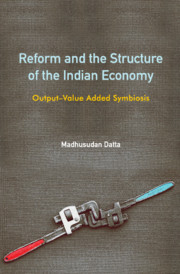Book contents
- Frontmatter
- Dedication
- Contents
- Tables
- Figures and Box
- Preface
- 1 Introduction: The Take-off
- 2 Growth and Structural Change since 1978–79: Issues in Measurement
- 3 Sectoral Shares in Indian GDP: How to Regard It?
- 4 Sectoral Growth: GVA–Output Dichotomy
- 5 Manufacturing Sector in the Indian Economy: Paradox of Growth and Stagnation
- 6 Growth and Sectoral GVA Adjustments
- 7 Demand for Intermediate Services
- 8 Linkages and Key Sectors in the Indian Economy
- 9 Conclusion: A Perspective of Indian Economic Growth
- References
- Index
2 - Growth and Structural Change since 1978–79: Issues in Measurement
Published online by Cambridge University Press: 17 March 2020
- Frontmatter
- Dedication
- Contents
- Tables
- Figures and Box
- Preface
- 1 Introduction: The Take-off
- 2 Growth and Structural Change since 1978–79: Issues in Measurement
- 3 Sectoral Shares in Indian GDP: How to Regard It?
- 4 Sectoral Growth: GVA–Output Dichotomy
- 5 Manufacturing Sector in the Indian Economy: Paradox of Growth and Stagnation
- 6 Growth and Sectoral GVA Adjustments
- 7 Demand for Intermediate Services
- 8 Linkages and Key Sectors in the Indian Economy
- 9 Conclusion: A Perspective of Indian Economic Growth
- References
- Index
Summary
When you have mastered numbers, you will in fact no longer be reading numbers, any more than you read words when reading books. You will be reading meanings.
—W. E. B. DuboisIntroduction
Production means activity by institutional units, as distinct from natural processes, intended to obtain a result in the form of goods or services. The process adds value to intermediate inputs with the help of primary inputs like capital and labour; this addition is gross value added. There was a time when agricultural activities were supposed to be the most crucial and there was a school of thought (the Physiocrats) that considered agricultural production alone to contribute to the national product. But this idea is not held by any significant group of economists today. Adam Smith distinguished activities in the categories ‘productive’ and ‘unproductive’ (Smith, 1776: 321). Most service activities, however lofty or revered (excluding those integrated directly with material production and distribution of the products), were classified as ‘unproductive’. The idea was that the level of material production determined availability of the basic necessities of life and resources needed for economic growth, while services were fleeting. The concept of net material product (Stone, 1970; UN, 1971) of the erstwhile socialist system, which counted only goods and (material) services directly associated with them, basically owed its construct to this idea. The broader concept of aggregate product, which has subsequently been formalized as the GDP, is now almost universally accepted as a measure of the extent of productive activity in a country (Beckerman, 1991; UN, 2009). Basically, GDP consists of gross value added (GVA) from activities of all kinds of institutional units resulting in production of goods and services using capital, labour and intermediate inputs of goods and services. This is identical to aggregate final expenditure in the absence of product taxes.
In the course of accumulation of knowledge manifested in technical progress, practically all productive activities undergo changes. Output per unit of labour increases, and over time this increment becomes phenomenal. Although production of most commodities increases in scale with growth of population, peoples’ consumption or other use (investment and export) of every commodity does not grow proportionately with income. This means the commodity composition of aggregate production changes.
- Type
- Chapter
- Information
- Reform and the Structure of the Indian EconomyOutput-Value Added Symbiosis, pp. 17 - 34Publisher: Cambridge University PressPrint publication year: 2020



